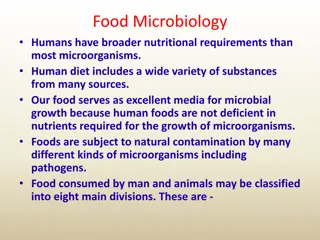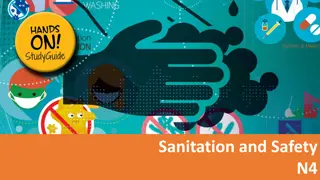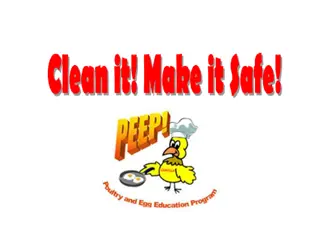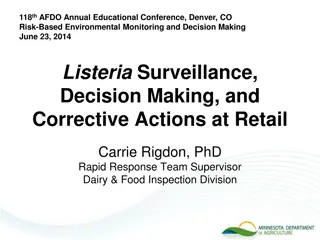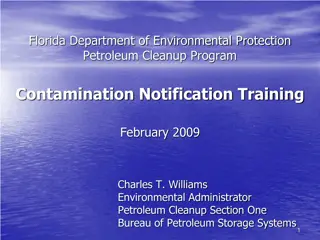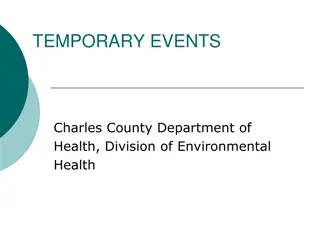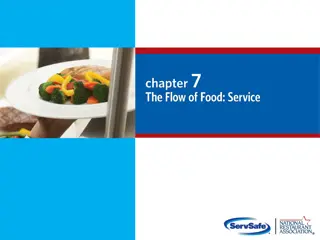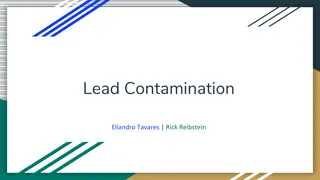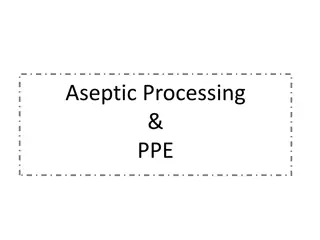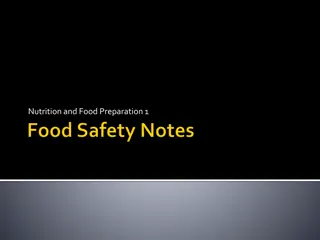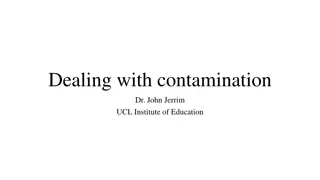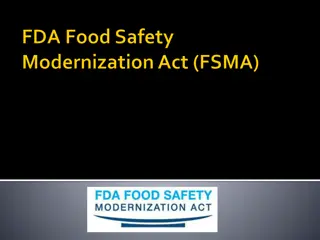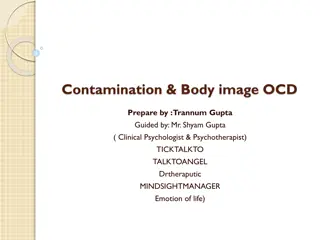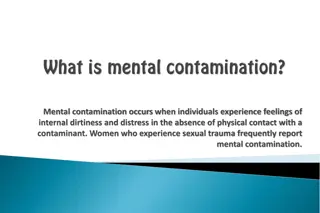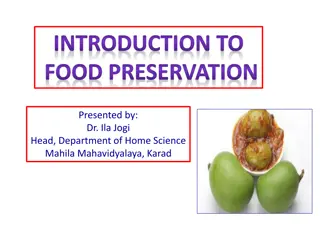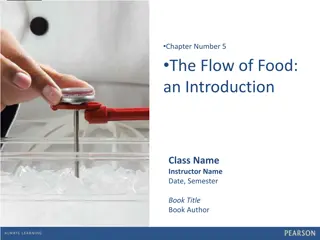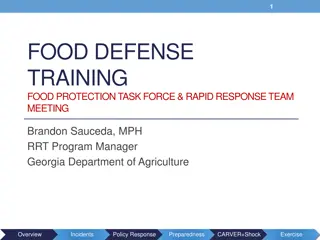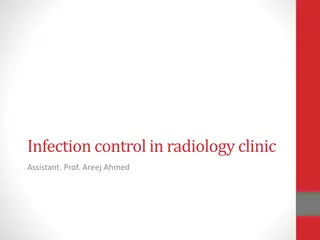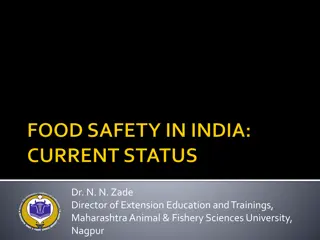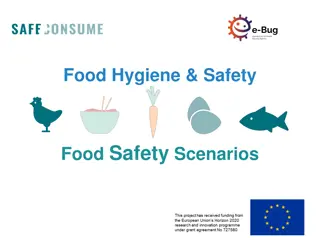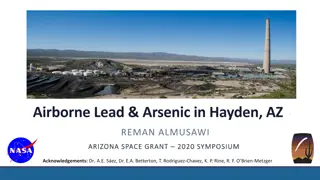Essential Food Safety Training Program in Abu Dhabi
The Essential Food Safety Training (EFST) program in Abu Dhabi is designed to equip food handlers with the knowledge and skills necessary to ensure safe food handling practices. Led by experienced trainers like Navas Khan A., the program covers essential pillars such as avoiding cross-contamination,
2 views • 26 slides
Role of Microorganisms in Food and Industry
Microorganisms play a crucial role in the food and industrial sectors, both benefiting and causing harm. They are involved in processes such as organic compound transformation, fermentation, and food production. While beneficial microorganisms contribute to the creation of various useful food produc
5 views • 44 slides
How are plant essential oils valuable as functional ingredients
Food Research Lab is one of the leading food industry consultants and offers various food production services. We provide food production and food manufacturing consultancy services to food, beverage and nutraceutical companies. Primary food production involves everything from food procurement, inve
8 views • 12 slides
Understanding Food Microbiology: Sources of Contamination
Humans have broader nutritional requirements than most microorganisms. The human diet includes a wide variety of substances, making our food excellent media for microbial growth. Natural contamination of food by various microorganisms, including pathogens, is common. Food consumed by humans and anim
0 views • 51 slides
Comprehensive Guide to Personal Hygiene in Food Handling
Understanding the importance of personal hygiene in food handling operations is crucial for maintaining a safe environment and preventing contamination. This guide explores the key practices and procedures involved in maintaining high standards of hygiene in food preparation, storage, and handling a
0 views • 30 slides
Importance of Meat Hygiene and Sanitation in the Meat Industry
Meat hygiene is essential to ensure the safety and suitability of meat for consumers. It involves implementing specific standards and regulatory actions to maintain cleanliness and prevent contamination at all stages of production. Proper cleaning and sanitization practices, adherence to legal stand
0 views • 16 slides
Safeguarding Your Kitchen: Preventing Cross-Contamination
Cross-contamination poses a risk of foodborne illnesses and can occur in multiple ways, such as using the same utensils for raw and cooked foods. Taking specific cleaning steps at home, like regularly cleaning dish cloths and sanitizing surfaces, is vital to preventing harmful bacteria from spreadin
0 views • 8 slides
Food Equipment Usage Guidelines for Safe Food Handling
Enhance your knowledge on using equipment for making food with proper safety procedures. Learn about essential points like wearing protective gear, checking hot food temperatures, food safety principles, and sanitization requirements. Understand machine settings, food temperature checks, and serving
1 views • 22 slides
Risk-Based Environmental Monitoring for Listeria Surveillance at Retail
Explore the importance of risk-based environmental monitoring and decision-making in detecting Listeria contamination in retail food settings. Learn about routine sampling plans, trends in positive samples, species distribution, and key locations of Listeria findings from 2010 to 2014. Discover why
1 views • 12 slides
National Food Reserve Agency (NFRA): Enhancing Food Security in Nigeria
The National Food Reserve Agency (NFRA) under the Federal Ministry of Agriculture & Water Resources plays a crucial role in addressing agricultural production, storage, and marketing challenges in Nigeria. With a vision to ensure sustainable food access for all Nigerians and become a global food pro
1 views • 30 slides
Contamination Notification Training: Florida Department of Environmental Protection
This document outlines the Contamination Notification Training provided by the Florida Department of Environmental Protection in February 2009. It covers types of contamination notification, governing statutes, rules, and guidance, specific noticing requirements, and changes from prior guidance. The
0 views • 25 slides
Guidelines for Temporary Food Service Operations at Charles County Events
In Charles County, temporary food service operations are defined as facilities operating with events lasting up to 30 days, requiring a permit from the Department of Health. The process involves submitting an application, meeting minimum requirements like proper waste disposal and food storage, and
1 views • 23 slides
Best Practices for Food Preparation to Ensure Food Safety
This chapter highlights essential practices for prepping food to prevent cross-contamination and time-temperature abuse in a food service setting. Topics covered include safe methods for thawing food, cooking temperatures, microwave cooking, informing consumers of risks, requirements for partially c
1 views • 25 slides
Food Safety Guidelines for Holding and Serving
Learn essential food safety guidelines for holding and serving food, including proper temperature control, handling preset tableware, re-serving food, and labeling bulk food in self-service areas. Follow these practices to prevent contamination and ensure food quality and safety for your customers.
0 views • 18 slides
Addressing Lead Contamination: Advocating for Effective Legislation
Working towards effective lead contamination legislation involves setting clear goals, engaging with experts and legislators, expanding testing and awareness efforts, and ensuring existing laws are enforced. Key figures like Senators Chang-Diaz and Eldridge are involved, along with advocacy at event
3 views • 6 slides
Exploring Food Science and Technology in Modern Society
Delve into the world of food science and technology with insights on what scientists do, the importance of understanding food, definitions of food science and food technology, factors affecting food spoilage, and traditional and modern food processing technologies. Gain knowledge on testing hypothes
0 views • 22 slides
Groundwater Contaminant Identification Through Water Sampling Techniques
This informative content discusses water sampling techniques used to identify contaminants in groundwater, focusing on factors such as FSMA regulations, total nitrogen levels, and best practices for sampling. It also addresses the importance of monitoring agricultural water quality to prevent microb
0 views • 28 slides
Understanding Aseptic Processing and Contamination Control in Cleanroom Environments
Aseptic processing involves maintaining a sterile environment to prevent contamination in cleanroom settings. The presence of non-viable and viable particulate contamination, such as dust and live microorganisms, poses challenges. Sources of contamination include equipment, structures, surfaces, and
0 views • 29 slides
Food Safety Practices in Service Industry
This chapter focuses on the essential food safety practices in the service industry, covering topics such as time and temperature requirements for holding food, ways to prevent time-temperature abuse and cross-contamination, minimizing bare-hand contact with food, preventing staff and customers from
0 views • 26 slides
The Safe Food Handler Training Program
This program focuses on essential food safety practices for food handlers, covering topics such as hand hygiene, use of gloves, proper attire, illness reporting, and more. Participants will learn how to prevent food contamination, maintain personal hygiene, and comply with regulations to ensure safe
0 views • 30 slides
Food Safety and Prevention of Food-borne Illnesses
An estimated 48 million Americans suffer from food-borne illnesses yearly, caused by harmful microorganisms due to poor food handling practices. Factors contributing to food-borne illnesses include improper cooking, inadequate storage, and cross-contamination. To prevent such illnesses, it is essent
0 views • 23 slides
Understanding Contamination in Research Studies
Understand the concept of contamination in research studies, its impact on the effectiveness of Randomized Controlled Trials (RCTs), and different analysis methods to handle contamination, such as Intention-to-Treat (ITT) and Contamination-Adjusted Intention-to-Treat (CA-ITT) analyses. Learn how to
0 views • 40 slides
Mastering Good Food Hygiene and Storage Practices
Understanding food spoilage causes, common food-poisoning bacteria, conditions for bacterial growth, ways to prevent food contamination, safe food handling practices, HACCP concept, types of perishable foods, importance of proper food storage, packaging materials for food, and recognizing signs of f
1 views • 27 slides
Guidelines for Animal Disposal Methods
Environmental and biosecurity guidelines recommend various disposal methods such as composting, rendering, permitted landfill, unlined burial, fixed-facility incineration, and open-air burning. Each method has specific selection criteria and considerations to minimize risks to the environment and bi
0 views • 17 slides
Agricultural Water Safety Regulations Overview
The final Produce Rule and Preventive Controls Rule, effective since November 13, 2015, set criteria for microbial contamination in agricultural water. Generic E. coli levels are key indicators, affecting water uses in post-harvest and production. Criteria like Geometric Mean and Statistical Thresho
0 views • 43 slides
Understanding Contamination OCD: Symptoms, Obsessions, and Misconceptions
Contamination OCD is a subset of OCD characterized by severe fears of becoming contaminated by germs or getting sick. Individuals with this condition may exhibit compulsions such as avoidance, excessive washing, and health testing. It's crucial to differentiate between normal intrusive thoughts and
0 views • 21 slides
Understanding Mental Contamination: Causes and Effects
Mental contamination is a phenomenon where individuals experience feelings of internal dirtiness and distress without physical contact with a contaminant. It is common among women who have experienced sexual trauma. Symptoms include fear of imagined contaminants, ritualistic acts to neutralize them,
0 views • 7 slides
Understanding Food Preservation: Techniques and Importance
Food preservation is a crucial aspect of ensuring food safety, extending shelf life, and preventing spoilage. This article delves into the definition of food preservation, its objectives, and the importance of preserving foods. From preventing microbial contamination to increasing food availability,
0 views • 10 slides
Food Safety and Cross-Contamination Prevention Guidelines
Understanding the flow of food is crucial in preventing cross-contamination at various stages of food handling. This chapter delves into key terms, temperature-measuring devices, calibration methods, and guidelines to prevent cross-contamination. By implementing separate equipment, proper cleaning,
0 views • 23 slides
Best Practices for Contamination Control in Pharmaceutical Manufacturing
Implementing a robust Contamination Control Strategy (CCS) as part of the Pharmaceutical Quality System is crucial for ensuring product quality and safety. The strategy encompasses various elements like process risk management, preventative maintenance, and personnel training. Manufacturers must foc
0 views • 19 slides
Food Defense Training and Rapid Response Team Meeting Overview
Food Defense Training and Rapid Response Team Meeting provides insights into food security, food defense, and food safety to protect against intentional and unintentional contamination incidents. The presentation delves into incidents, policies, responses, and preparedness, emphasizing the importanc
0 views • 24 slides
Understanding Food Justice and Insecurity: A Comprehensive Overview
Food Justice Primer provides insightful definitions and discussions on key concepts such as food justice, food insecurity, food sovereignty, and food deserts. It highlights the need for equitable sharing of benefits and risks in the food system, aiming to transform current disparities and inequities
0 views • 49 slides
Food Sufficiency and Barriers to Free Food Access Among Working-Age Persons with Disabilities Before and During COVID-19 Pandemic
Working-age persons with disabilities face economic vulnerability and higher chances of living in food-insecure households. This study explores food sufficiency and barriers to accessing free food during the COVID-19 pandemic. Data was collected through an online survey, revealing insights into food
1 views • 14 slides
Understanding the Impact of Aflatoxin Contamination in Africa
Aflatoxins, fungal metabolites produced by Aspergillus flavus, pose a significant challenge in Africa, affecting various crops and leading to health risks, including liver cancer and immune suppression. The contamination impacts trade, agriculture, and food security, with regulations affecting regio
0 views • 31 slides
Royal Society of Chemistry Food Group Vision & Mission Summary
The Royal Society of Chemistry Food Group aims to lead, promote, and disseminate the understanding and importance of chemistry in food. Their vision is to enhance food and nutrition security through advancing the chemistry of food ingredients. They strive to engage with various communities to promot
0 views • 4 slides
Exploring Pesticide Monitoring and Contamination Studies in Maine
Mary Tomlinson's work with the Maine Board of Pesticides Control includes past studies on groundwater and surface water monitoring, ongoing monitoring initiatives, and future collaborative studies. The State Law mandates residue surveys to identify possible contamination sources and develop a pestic
1 views • 55 slides
Radiographic Infection Control in Dental Clinics
In dental radiology clinics, infection control is crucial to prevent cross-contamination and disease transmission among patients and staff. Key steps include applying standard precautions, wearing personal protective equipment, disinfecting equipment, and preventing contamination of processing equip
0 views • 16 slides
Food Safety Challenges in a Changing World
Eating food poses risks, and maintaining food safety is crucial. Factors like changing habits, processing methods, and global trade impact food safety. Diseases like acute diarrhoea are a global concern, emphasizing the need for vigilance. Ecosystem changes also contribute to food safety challenges,
0 views • 39 slides
Food Hygiene & Safety Scenarios: Learning the Importance of Proper Food Handling
Explore three scenarios highlighting the significance of food hygiene and safety. From understanding the consequences of foodborne illnesses to recognizing the importance of following proper food handling practices, these scenarios shed light on critical aspects of food safety. Learn how simple acti
0 views • 7 slides
Airborne Lead and Arsenic Contamination in Hayden, Arizona Study
Monitoring and analysis of airborne lead and arsenic contamination in Hayden, Arizona revealed significant levels of pollutants stemming from industrial activities. The study site at Hayden High School showed elevated lead deposition fluxes and surface dust contamination, posing potential health haz
0 views • 10 slides



